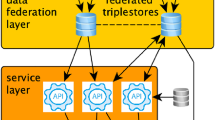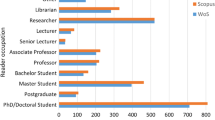Abstract
The concept of citation indexing has become deeply involved in many parts of research itself and the broad environment in which research plays an integral role, ranging from research evaluation, numerous indicators, to an increasingly wider range of scientific disciplines. In this article, we pay tribute to Eugene Garfield and present a scientometric review of the intellectual assets that he brought to us. In addition, we explore the intellectual landscape that has subsequently evolved in connection to many of his ideas. We illustrate what systematic reviews of the scientific literature may reveal and what we may learn from the rich information conveyed through citation-induced patterns. The study is conducted with CiteSpace, one of many science mapping tools based on data from the Web of Science and Scopus. Without Garfield’s inventions, none of these would be possible.



















Similar content being viewed by others
References
Bensman, S. J. (2007). Garfield and the impact factor. Annual Review of Information Science and Technology, 41(1), 93–155.
Bornmann, L., Haunschild, R., & Leydesdorff, R. (in press). Reference publication year spectroscopy (RPYS) of Eugene Garfield’s publications. Scientometrics.
Bornmann, L., Haunschild, R., & Hug, S. E. (in press). Visualizing the context of citations referencing papers published by Eugene Garfield: A new type of keyword co-occurrence analysis. Scientometrics.
Chen, C. (2004). Searching for intellectual turning points: Progressive knowledge domain visualization. Proceedings of the National Academy of Sciences of the United States of America, 101(suppl), 5303–5310.
Chen, C. (2006). CiteSpace II: Detecting and visualizing emerging trends and transient patterns in scientific literature. Journal of the American Society for Information Science and Technology, 57(3), 359–377.
Chen, C. (2017). Science mapping: A systematic review of the literature. Journal of Data and Information Science, 2(2), 1–40.
Chen, C., Hu, Z., Liu, S., & Tseng, H. (2012). Emerging trends in regenerative medicine: A scientometric analysis in CiteSpace. Expert Opinions on Biological Therapy, 12(5), 593–608.
Chen, C., Ibekwe-SanJuan, F., & Hou, J. (2010). The structure and dynamics of co-citation clusters: A multiple-perspective co-citation analysis. Journal of the American Society for Information Science and Technology, 61(7), 1386–1409. https://doi.org/10.1002/asi.21309.
Garfield, E. (1996). How can impact factors be improved? British Medical Journal, 313(7054), 411–413.
Garfield, E. (1998). From citation indexes to informetrics: Is the tail now wagging the dog? International Journal of Libraries and Information Studies, 48(2), 67–80.
Garfield, E. (1999). Journal impact factor: A brief review. Canadian Medical Association Journal, 161(8), 979–980.
Garfield, E. (2006). The history and meaning of the journal impact factor. JAMA: Journal of the American Medical Association, 295(1), 90–93.
Jaro, M. A. (1989). Advances in record linkage methodology as applied to the 1985 census of Tampa Florida. Journal of the American Statistical Association, 84(406), 414–420.
Leydesdorff, L. (2010). Eugene Garfield and algorithmic historiography: Co-words, co-authors, and journal names. Annals of Library and Information Studies, 57(3), 248–260.
Leydesdorff, L., & Bornmann, L. (2011). How fractional counting of citations affects the impact factor: Normalization in terms of differences in citation potentials among fields of science. Journal of the American Society for Information Science and Technology, 62(2), 217–229.
Saha, S., Saint, S., & Christakis, D. A. (2003). Impact factor: A valid measure of journal quality? Journal of the Medical Library Association, 91(1), 42–46.
Small, H. (2017). A tribute to Eugene Garfield: Information innovator and idealist. Journal of Informetrics, 11(3), 599–612.
Tibély, G., Pollner, P., Vicsek, T., & Palla, G. (2013). Extracting tag-hierarchies. PLoS ONE, 8(12), e84133.
van Raan, A. F. J., & Wouters, P. (2017) Eugene Garfield 1925–2017: Visionary information scientist. https://www.cwts.nl/news?article=n-q2y2c4&title=eugene-garfield-1925–2017-visionary-information-scientist.
Acknowledgements
I’d like to thank Lutz Bornmann for kindly sharing the set of 1558 records for the study.
Author information
Authors and Affiliations
Corresponding author
Rights and permissions
About this article
Cite this article
Chen, C. Eugene Garfield’s scholarly impact: a scientometric review. Scientometrics 114, 489–516 (2018). https://doi.org/10.1007/s11192-017-2594-5
Received:
Published:
Issue Date:
DOI: https://doi.org/10.1007/s11192-017-2594-5




